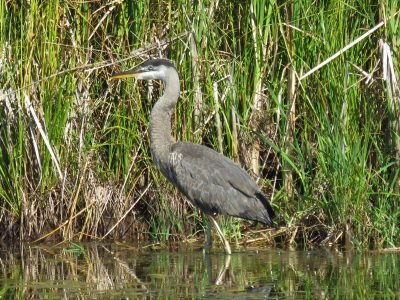UP deer herd in fair shape
Northwoods Notebook
- Though taking in plenty of solid food, this well-grown fawn still would nurse when its mother allowed. The doe’s size and single fawn probably indicates she’s a first-time mother; after their first year of breeding, does typically will bear twins or even triplets. (Betsy Bloom/Daily News photo)
- Found a few weeks ago almost starved to death with a stick lodged in its mouth, this juvenile great blue heron recovered enough under wildlife rehabilitator Phyllis Carlson’s care to be released Monday. (Phyllis Carlson photo)

Though taking in plenty of solid food, this well-grown fawn still would nurse when its mother allowed. The doe’s size and single fawn probably indicates she’s a first-time mother; after their first year of breeding, does typically will bear twins or even triplets. (Betsy Bloom/Daily News photo)
Fears that the snowy, prolonged end to the winter this year would take a heavy toll on the region’s deer herd for now appear to have not come to pass.
An early survey of this spring’s fawn crop, along with the ongoing deer movement study in the Upper Peninsula, indicates while fawn numbers did decline, it was not nearly the level seen after the severe winters of 2012, 2013 and 2014, said Cody Norton, large carnivore specialist for the Michigan Department of Natural Resources.
The ratio of fawns to adults is down 20 percent from 2018, Norton said. Other indicators point to the herd overall as weathering the winter in decent shape.
“It should be a pretty darn good hunting season,” he said.
While no hard data yet exists, Norton also said reports from DNR staff in the field have echoed what several people have noticed in Dickinson County — fewer does seen with twins or triplets.

Found a few weeks ago almost starved to death with a stick lodged in its mouth, this juvenile great blue heron recovered enough under wildlife rehabilitator Phyllis Carlson’s care to be released Monday. (Phyllis Carlson photo)
Several factors could explain this, he said. The winter might have left the does in poorer condition, leading to only one viable fawn.
The herd, too, is younger after several mild winters followed the three severe ones, letting a new generation get established. A doe typically is bred in its second fall and has a single fawn the first year it gives birth — nature’s way of not giving an inexperienced mother too much to handle. After that, the doe usually will produce multiples, though all may not survive.
The DNR does a fall deer camp study as well to again get a count on the fawn-to-adult ratio, Norton said. That should be a better indicator of what the herd is like going into the winter.
Bucks, too, will be part of the fall survey, though much of that data will come from hunters who register their kills. The DNR looks at not just antler size but tooth wear and other indicators of age.
Early reports, again, point to the bucks born after the three bad winters now drawing close to maturity. Those that make it through this hunting season likely will be in their prime next year, Norton said.
“It should just keep getting better,” he said of the buck numbers and size.
*****
Another reason why deer numbers have been able to rebound from the lows seen earlier in the decade: predators have had their own problems.
Coyotes three to four years ago hit perhaps the lowest density seen in recent decades, Norton said. While the past couple years have been better, numbers still have not recovered, he said.
Some of that can be attributed to wolves asserting themselves in the region, as they will kill coyotes as competitors if they can, he said. But a more likely reason is a wave of distemper that hit raccoons hard as well, judging by the number of calls from the public of seriously ill raccoons showing up at homes.
Bobcats have been more scarce as well, to the point a decision was made to require one of the two tags available for bobcat each year be limited to private land only in the Upper Peninsula, Norton said.
It’s unclear why bobcat might be struggling, although winters with heavy snow make it more difficult for predators in general to locate and chase prey.
A predator in poor condition, in turn, produces fewer pups or kits, and may lose them for lack of food.
A good indicator of fewer larger predators, Norton said, is if cottontail rabbit numbers rise. More snowshoe hares may appear as well, but that population will follow cycles, not unlike ruffed grouse.
*****
An update on the juvenile great blue heron that wildlife rehabilitator Phyllis Carlson took in earlier this month after it was found drooping in the water just off the beach at Hamilton Lakes’ Big Pine Resort.
That day, the bird was so thin and weak it barely stirred even when surrounded by a dozen or more children, Carlson said. It turned out to have a 4-inch stick stuck in the top of its mouth, blocking its throat and preventing it from swallowing anything.
Though it probably would not have survived another day if not taken in, Carlson predicted the bird would make a full recovery with some time and feeding.
That turned out to be the right assessment. Monday, she was able to release a much more lively and robust “Terri Dactyl” at the Norway Myr, a group of shallow pothole ponds where the heron should find plenty to eat — if it hasn’t become too accustomed to being served up fresh live minnows and thawed mice.
Carlson said she’s confident Terri D hasn’t forgotten it’s a heron — it immediately waded into the water and began scanning, even making a few stabs while she watched.
“He knows what he’s supposed to do,” she said.
Betsy Bloom can be reached at 906-774-2772, ext. 40, or bbloom@ironmountaindailynews.com.






